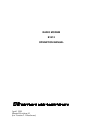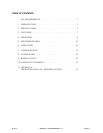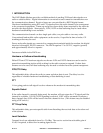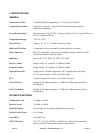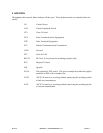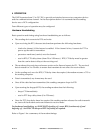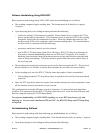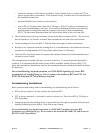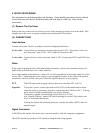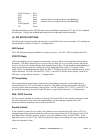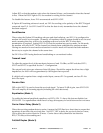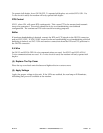1 IN TRO DUC TION
The B1474 Radio Modem provides a reliable method of sending 1200 baud data signals over
radio or cable facilities. Digital information is converted to tone format for transmission over
the communication channel. Received tones are converted back to RS232 digital format.
Hardware handshaking using RTS and CTS signals allows the radio channel to be transparent
to the connected equipment. Warm-up and power down delay times required by the radio do
not affect the data signals. Alternatively, XON/XOFF or data buffering may be used where
hardware handshaking is not available.
The communication channel can be a single pair cable, two pair cable or two-way radio.
Conventional land mobile radio equipment can be used or, if specified at time of order, GE
trunking radios may be used.
Power and audio signals are connected to compression terminals inside the modem; the digital
interface is through a DB-25S connector. The B1474 requires 12 to 30 VDC, negative ground,
and approximately 60 mA to operate.
Features available in the B1474 are:
Hard ware or Soft ware Hand shak ing
Either RTS and CTS hardware signals or software XON and XOFF characters can be used to
pause the transmitting station while waiting for the radio system to respond. If short data
streams are to be sent, full data buffering may be used to render the radio system transparent.
RTS/CTS De lay
This adjustable delay allows the radio to warm up before data is sent. The delay is active
regardless of whether hardware handshaking or data buffering is used.
PTT
A low going push-to-talk signal is active whenever the modem is transmitting data.
Squelch De tect
If the radio channel is currently being used, the modem will not return the CTS signal until the
channel is available. If XON/XOFF signaling is selected, XOFF will be returned to indicate a
busy channel; then XON will be issued when the channel is free. (This feature may be disabled
using a DIP switch.)
PTT Drop De lay
This adjustable delay prevents squelch tails from disturbing the received data at the other end
of the system.
Level Se lec tion
Transmit levels are adjustable from 0 to -20 dBm. The receive section has selectable gain of
10 dB, if required, to boost low incoming signal levels.
B1474
BARNETT EN GI NEERING LTD.
PAGE
3



